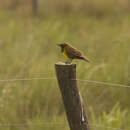Comprehensive Description
provided by Smithsonian Contributions to Zoology
Pseudoleistes virescens (Vieillot)
Previously (Friedmann, 1929:120–121) this species was known to be a very frequent host choice in Argentina, and that there it often had excessive numbers of shiny cowbird eggs in its nests. Hudson was quoted to the effect that he found as many as 14, and, in one case, 16 of the parasitic eggs in single nests. “In some seasons all the nests … found and watched were eventually abandoned by the birds on account of the number of parasitical eggs dropped in them.” Similarly, in the province of Entre Rios, Smyth (1925) found nests of this host with 8, 10, 11, 12, 15, and 17 cowbird eggs apiece! Very different was the experience of Dr. Gordon H. Orians in the province of Buenos Aires, in October–November 1973, discussed more fully under Agelaius thilius herein. He found 51 nests of this marshbird and 10 of these contained a single cowbird egg apiece in addition to those of the host, 2 of the nests had 2 cowbird eggs each. Dr. Orians informs us that 13 of the 14 cowbird eggs were of the usual speckled coloration and 1 was unmarked white. Hudson, the first man to study these birds, thought that the Pseudoleistes may eject pure white, unspotted cowbird eggs, but retain and incubate mottled ones. He often found cowbird eggs on the ground under the nests.
Santos (1940:271) found this bird to be victimized in southeastern Brazil, and recently we have been informed by Eugene Gerzenstein that it is often parasitized in Uruguay as well.
RED-BREASTED BLACKBIRD
- bibliographic citation
- Friedmann, Herbert, Kiff, Lloyd F., and Rothstein, Stephen I. 1977. "A further contribution of knowledge of the host relations of the parasitic cowbirds." Smithsonian Contributions to Zoology. 1-75. https://doi.org/10.5479/si.00810282.235

